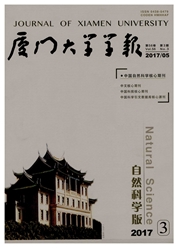

 中文摘要:
中文摘要:
抗菌肽或抗微生物肽因具有杀死或抑制微生物的共同特性,近年来科学家又将这些肽类称为"天然抗生素",有望在将来作为一种新型的生物药物替代现有的化学类抗生素.海洋动物中蕴藏着世界上丰富的抗菌活性物质,研究与开发应用海洋动物抗菌肽成为近年来的研究热点.结合国内外的相关研究进展,简要总结了课题组近年来在我国海水养殖鱼类抗菌肽hepcidin和青蟹抗菌肽scygonadin的研究进展,从抗菌肽的蛋白分离、纯化、基因克隆、基因表达模式、基因工程表达以及抗菌肽合成与表达产品的抗菌活性等进行了简要细致的叙述,对深入探索海洋动物抗菌肽在我国水产养殖业的开发应用具有重要的参考价值.
 英文摘要:
英文摘要:
The small native compounds are isolated from various species of lives,with resistant activity against bacteria,are known as "antibacterial peptides"or "antimicrobial peptides"(AMPs) and are also thought as "natural antibiotics" in recent years by scientists.It is widely acknowledged that these defensive compounds or AMPs could become new types of bio-antibiotics substituting for the currently used chemical antibiotics in near future.More and more people in the world realize that there are luxuriant AMPs existing in the marine animals,plants and microorganisms.The study of AMPs in marine animals is now the hotspot in research,thus attracting many researchers engaged in this area.The author briefly summarizes some typical results obtained from the study of AMPs in his group in recent several years.His group has done a lot of work in mining of genes and isolation of proteins which are related to antimicrobial activity from Chinese cultured fishes and crabs.More than 20 hepcidin cDNA sequences have been identified and the gene expression patterns were investigated in normal and bacterial challenged fish including Lateolabrax japonicus,Pagrus major,Sparus macrocephlus,Tilapia nilotica,Pseudosciaena crocea.Meanwhile,a novel anionic antimicrobial peptide named scygonadin was in detailed described,which was first isolated by HPLC from the seminal plasma of Scylla serrata and was characterized by mass spectral analysis in his group.Its cDNA sequence was revealed and its expression patterns in tissues and in the developmental stages from embryo to maturation in crabs were investigated.Furthermore,the synthetic and recombinant peptides of hepcidin and scygonadin are confirmed to be potent active against Gram-positive bacteria,Gram-negative bacteria and fungi.Based on the developed appropriate methods for producing large quantities of AMPs using gene engineering techniques and combining with the strong antimicrobial activity these AMPs are potential to be used in veterinary medicine and aquaculture.
 同期刊论文项目
同期刊论文项目
 同项目期刊论文
同项目期刊论文
 A male-specific expression gene, encodes a novel anionic antimicrobial peptide, scygonadin, in Scyll
A male-specific expression gene, encodes a novel anionic antimicrobial peptide, scygonadin, in Scyll 期刊信息
期刊信息
